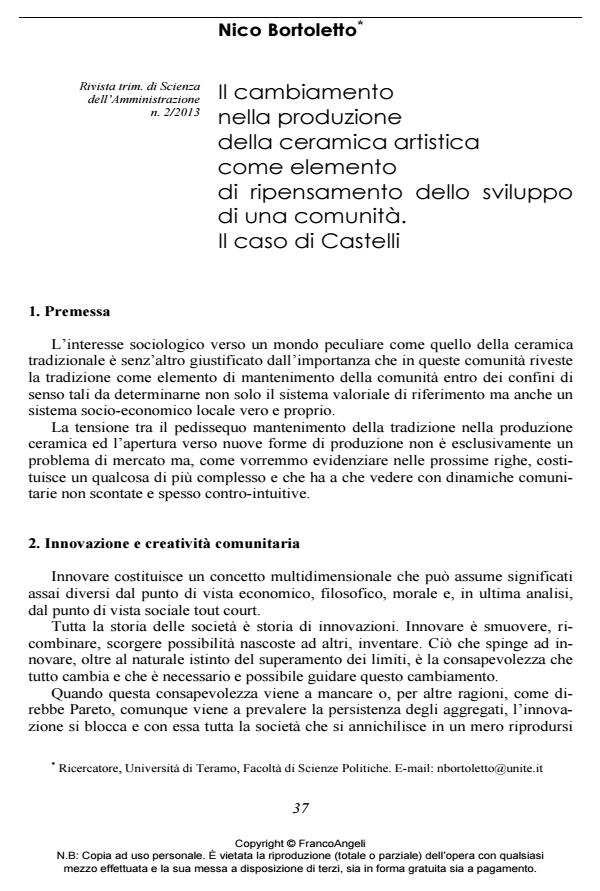Il cambiamento nella produzione della ceramica artistica come elemento di ripensamento dello sviluppo di una comunità. Il caso di Castelli
Titolo Rivista RIVISTA TRIMESTRALE DI SCIENZA DELL’AMMINISTRAZIONE
Autori/Curatori Nico Bortoletto
Anno di pubblicazione 2013 Fascicolo 2013/2
Lingua Italiano Numero pagine 14 P. 37-50 Dimensione file 427 KB
DOI 10.3280/SA2013-002003
Il DOI è il codice a barre della proprietà intellettuale: per saperne di più
clicca qui
Qui sotto puoi vedere in anteprima la prima pagina di questo articolo.
Se questo articolo ti interessa, lo puoi acquistare (e scaricare in formato pdf) seguendo le facili indicazioni per acquistare il download credit. Acquista Download Credits per scaricare questo Articolo in formato PDF

FrancoAngeli è membro della Publishers International Linking Association, Inc (PILA)associazione indipendente e non profit per facilitare (attraverso i servizi tecnologici implementati da CrossRef.org) l’accesso degli studiosi ai contenuti digitali nelle pubblicazioni professionali e scientifiche
Questo articolo propone uno studio di caso su di una comunità locale, quella di Castelli (TE), nota per la secolare produzione tradizionale di ceramiche. Dopo un breve cenno storico e di contestualizzazione socio-economica viene preso in considerazione il dipanarsi, nello sviluppo del luogo, di alcuni elementi strettamente legati al mantenimento dei confini comunitari entro un ambito di sostenibilità relazionale. In particolare l’articolo evidenzia l’apparente aporia tra la necessità di conservare una tradizione - che in questo caso rappresenta anche il fondamento socio-economico della comunità - e la necessità di uno sviluppo economico da conseguirsi in misura tale da prevenire l’annichilimento della comunità stessa attraverso i consueti meccanismi migratori, tipici della montagna abruzzese. Si è verificata l’esistenza di meccanismi adattivi che influenzano l’equilibro generale della comunità attraverso un uso della tradizione in un senso di chiusura operativa del sociale verso il nuovo percepito non come possibilità ma come rischio. Si è concluso che tale strategia di chiusura operativa è sostenibile solo fino ad un certo punto, oltre il quale subentrano rischi di autoreferenzialità tali da poter innescare lo stesso effetto entropico verso il quale tale chiusura era posta in essere.
Parole chiave:Tradizione, comunità, ceramiche artistiche
Nico Bortoletto, Il cambiamento nella produzione della ceramica artistica come elemento di ripensamento dello sviluppo di una comunità. Il caso di Castelli in "RIVISTA TRIMESTRALE DI SCIENZA DELL’AMMINISTRAZIONE" 2/2013, pp 37-50, DOI: 10.3280/SA2013-002003